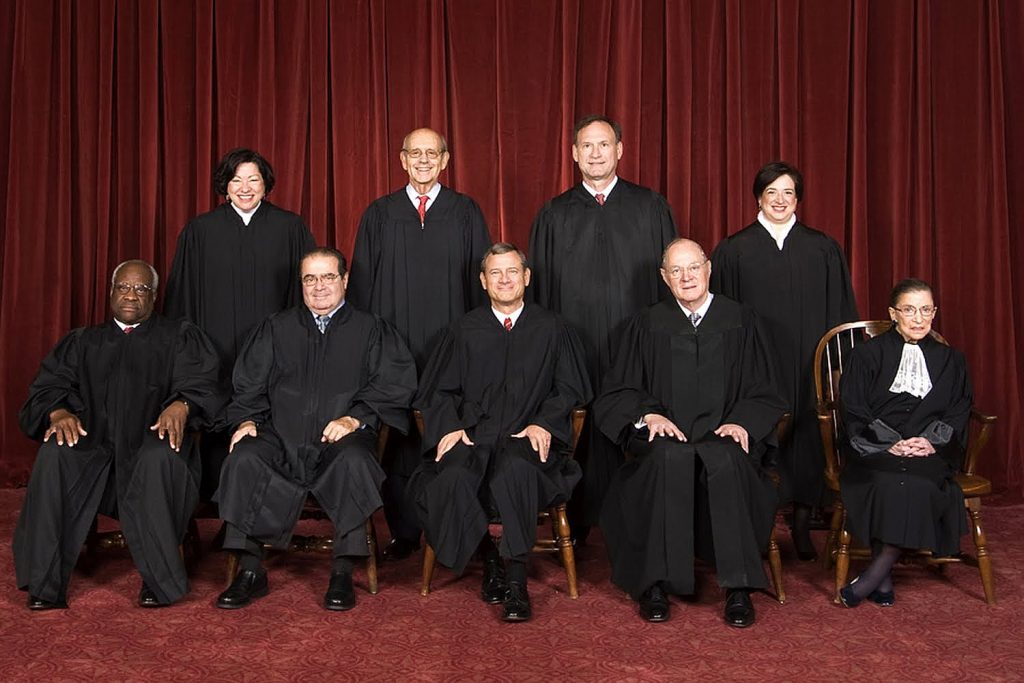
Today the Supreme Court hears arguments in round two of Fisher v. Texas.
Abigail Fisher, you will recall, claimed (and still claims) that the University of Texas’s admission preferences for blacks and Hispanics amounted to racial discrimination against her because she is white. In round one the Supremes almost agreed but instead vacated and remanded the case to the Fifth Circuit to determine if it was really, really necessary for UT to discriminate against Ms. Fisher in order to perform its educational mission. The Fifth Circuit sided with the University again, and the Supreme Court will now consider the matter a second time.
Related: Fisher II–A Mystery Solved
In “Race & Admissions: Round 2 at Supreme Court” a week ago, the National Law Journal briefly summarized the case and presented representative excerpts from three amicus briefs supporting Ms. Fisher and three supporting UT’s race preference policy. The latter three — presenting the views of the military, large corporations, and elite universities, what an earlier generation would have called “The Establishment” — deserve a close look. Following are excerpts their arguments and my comments.
Thirty-six former military leaders: University admissions policies, including those at the University of Texas at Austin, determine the makeup of our officer corps. As was true when Grutter was decided, our military cannot achieve a racially diverse officer corps if universities are required to turn a blind eye toward race.
Translation: If universities are forced to treat all applicants equally, without regard to their race, i.e., “turn a blind eye toward race,” the military will find it much more difficult to discriminate based on race in selecting and promoting our officers. It would be required, in short, to limit its evaluation criteria to non-racial qualifications such as merit and leadership ability.
Fortune 100 companies: For amici to succeed in their businesses, they must be able to hire highly trained employees of all races, religions, cultures, and economic backgrounds…. [The following sentence is from the brief but was not quoted by the National Law Journal.] Amici are dedicated to promoting diversity as an integral part of their business, culture, and planning. But amici cannot reach that goal on their own.
Translation: It’s easier for us to discriminate in hiring if universities have discriminated in admissions. (See the military argument, above.) The Supreme Court has, unfortunately, allowed higher education institutions to engage in racial discrimination to promote “diversity” under certain theoretically strict conditions, and they are required to demonstrate that “diversity” is in fact critically important for their academic mission. That license (and corresponding requirement), however, has never been extended to corporations.
Related: 25 Years on the AA Firing
The corporate brief also engages in hyperbole, as when it asserts, “It also is critical to amici that all of their university-trained employees have had the opportunity to share ideas, experiences, viewpoints, and approaches with a broadly diverse student body.” (Emphasis in original) Really? All university-trained employees? If true, that would mean these diversity-addicted corporations refuse to hire graduates of the sixty or so all-women colleges in the United States.
University of Michigan: Despite persistent and varied efforts to increase student-body racial and ethnic diversity by race-neutral means; despite committed efforts by University faculty, staff, students, and alumni to conduct race-neutral recruiting and admissions programs; and despite admissions consideration and extensive financial aid for socioeconomically disadvantaged students, admission and enrollment of underrepresented minority students have fallen precipitously in many of U-M’s schools and colleges since Proposal 2 [banning affirmative action in the state] was enacted.
Translation: The amount of ‘diversity” we formerly enjoyed, and wish we could continue requires deep and extensive preferences based on race, not simply a “plus factor” in close cases. Indeed it does; the degree of decline in minority admissions after the prohibition of racial preference is in fact the best measure of the magnitude of the preferences that had previously been awarded.
The University of Michigan brief trumpets the fact that “In 2006—the last admissions year before Proposal 2 took effect—… Black undergraduate enrollment was 7.03% …; for the past five years it has ranged between 4.41% and 4.71%.” Aside from whether or not this is a “precipitous” decline and whether or not it should justify preferential treatment of black applicants, the demographics of the UM population are considerably more complex, and even confusing, than the brief’s cherry-picked numbers suggest.
In 2006, for example, the supposed high-water mark of “diversity,” according to the University of Michigan’s Office of the Registrar Ethnicity Report, 59.7% of the total enrollment was white and 12.1% was Asian. According to the 2015 Report, however, after nine years of allegedly “precipitously” declining enrollment of underrepresented minorities, whites were only 56.2% and Asians 11.2% of total enrollment. Go figure.
Related: The Sixth Circuit Undermines AA
There is no mention, of course, in any of these briefs of the rise or fall of the numbers of Jews, Muslims, Evangelical Christians, or other minorities who presumably also can contribute to “diversity.”
The Supreme Court’s begrudging and half-hearted legitimization of racial preferences from Bakke through Grutter to Fisher has contributed enormously to a vast state-sponsored racial spoils system and hence increased racial divisiveness. In Fisher II, the court has the opportunity to undo some of this damage.
I hope no one is getting too excited that SCOTUS is going to declare AA unconstitutional.
Excellent analysis. It is so easy to spot the logical flaws in the arguments made by the people and groups that want to keep the US from ever reaching a time when our institutions are really color blind that one has to suspect that their claims are mere smokescreens for something else. I suggest that something else is the irresistible penchant for social engineering that we see in statists and big government cronies.